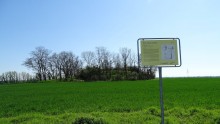|
|
|
|
PohlsbergRound Barrow(s)
|
||||||||||||||||||
|
|
|
Images (click to view fullsize) |
|
Photographs:
 Maps / Plans / Diagrams:
Maps / Plans / Diagrams:



|
Fieldnotes |
|
|
Pohlsberg is located south of Latdorf, about 400 meters after the end of the village, on the right side in the field. Pohlsberg is a multi-phase burial mound of the Neolithic and Bronze Age. In the area there are some more preserved grave mounds, e.g. 1.5 km east the Pfingstberg and 1.5 km west the Spitzes Hoch. The elongated hill is oriented approximately east-west. It has a length of 40 m, a width of 18 m and an average height of 4 m. In 1904 an excavation took place under the direction of Paul Höfer. The finds are now in the castle museum Bernburg. You drive on the Bernburger Straße (L64) through Latdorf in the direction of Gerbitz. In the middle of the village, turn right (east) into Poleyer Straße, which turns into a dirt road at the end of the village. Follow this road for about 400 m before reaching the Pohlsberg on the right. At the edge of the field a sign was errected in 2011 by the "Arbeitskreis Archäologie im Bernburger Land e.V.". |
21st May 2019ce Edited 21st May 2019ce |
|
taken from the information board Arbeitskreis Archäologie im Bernburger Land e.V.: Der Pohlsberg Middle and Late Neolithic Baalberg culture approx. 4,100 - 3,600 BC Bernburg culture approx. 3,300 - 2,700 BC Globular Amphora culture approx. 3,100 - 2,700 BC Corded Ware culture approx. 2,800 - 2,200 BC Late Bronze Age: approx. 1,300 - 775 BC One of the most important burial mounds for the archaeological research history prehistoric in Bernbuerger Land is the Pohlsberg. The long 4m high terrain was threatened by a gravel pit at the beginning of the 20th century. At the suggestion of the Bernburg Historical and Antiquity Society, founded in 1877, fortunately in September 1904 an excavation of the hill was carried out. The excavation was led by Paul Höfer (1845-1914), at that time one of the leading archaeologists in Central Germany. Three years earlier, he was involved in the excavation of the Schneiderberg in Baalberge. Höfer's precise and for his time very advanced excavation method, namely his specific observation of the deposit conditions, contributed significantly to the clarification of the temporal sequence of the various archaeological groups. The mound was built in the middle Neolithic period by the bearers of the so-called Baalberg Culture (4,100 - 3,600 BC). It surrounded a stone-tomb built inside. During the Neolithic period, burials were continued by members of the Bernburg culture (3,300 - 2,700 BC), the Globular Amphora culture (3,100 - 2,700 BC) and the Corded Ware culture (2,800 - 2,200 BC). More than 1,000 years later, the late Bronze Age population reused the mound as a place of burial. In contrast to the body burials of the Neolithic period, these are now cremation burials in urns. A special find ensemble of this period represents a richly equipped sword grave. It was a secondary burial in a cleared stone cist of the Neolithic period. Noteworthy is the peculiar (very slim) clay pot with lid, which contained a number of interesting additions to the ashes of the dead. The sword, a so-called "Griffzungenschwert", has references to Mycenae. Next there are eight bronze rings, six buttons, one tweezers, one chisel and one needle. |
19th May 2019ce Edited 21st May 2019ce |

